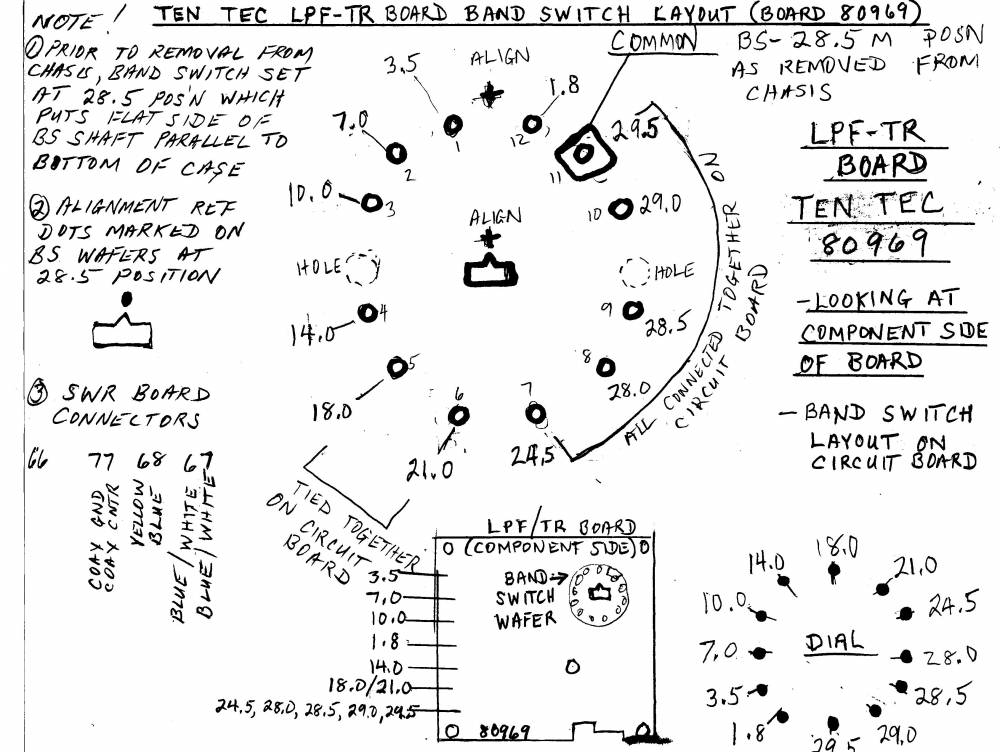This is an old revision of the document!
Corsair II - Troubleshooting Weak Receive on higher bands
From the Ten-Tec Reflector June 8, 2016 and supplemental info from Rick VE3ORY
The problem typically presents with these symptoms, as Marco IS0KYB described: On some bands (mostly from 15m upwards) I noticed a weak reception when I use the main antenna input. The problem goes away if I switch to the RX antenna. No, it doesn't seem to be the RX ant switch :) I cleaned it and operated it 100 times… it doesn't even scratch. I believe that the culprit is a faulty switching diode among D1-D6 in the rx/tx switch.
Rick VE3ORY responded to Marco's post: Like Marco I suspected the problem to be diodes related to T/R switching, however the problem turned out to be in the High Pass Filter circuit on the LPF-TR board (80969). Symptoms were identical to what Marco is indicating, and I found that receive strength was normal if I connected the antenna to the 'RX ANT' connector on the rear panel, which effectively bypasses the SWR and LPF-TR boards (and the High Pass Filter).
My original TEN TEC manual has notation showing "OPTIONAL HIGH PASS FILTER NOT INSTALLED" . However once I got the LPF-TR board removed I discovered that the "Optional" High Pass filter was in fact installed contrary to the notation on the schematic. Trouble shooting eventually led me to disconnecting and bypassing the High Pass Filter and receive performance issue was resolved. I did this by opening the circuit at the input to the High Pass Filter and bypassing it with a capacitor between Q2 collector and the RX connector to avoid interfering with operation of Q2. It has worked fine ever since and no noticeable issue without the "Optional" High Pass Filter.
The biggest challenge in all of this was getting the LPF-TR board out of the chassis which required careful removal of the Band Switch shaft while ensuring that all of the Band Switch wafer sections were in the correct position when reinserting the switch shaft.
While trouble shooting my problem I also discovered some changes on the LPF-TR board regarding biasing resistors for the PIN diodes. I bought my Corsair II new from a dealer at the Dayton Hamfest so presumably these changes were done at the TEN TEC factory. I recall reading somewhere about improvements to performance in PIN diode biasing, however I did not make these changes to my Corsair and so can only presume they were made at the factory but not documented by TEN TEC on the schematic.
Regardless of who did the modification, here is what I found on the LPF-TR board in my radio:
1. 470 ohm resistors were installed in series with D1 and D2
2. R3 had been changed from 330 ohms to a 100 ohm resistor
3. R6 had been changed from 150 ohms to a 47ohm resistor.
Board Removal
Below is a jpg showing info regarding layout of the Bandswitch components on TEN TEC, LPF-TR Board 80969.
The drawing is a bit scattered but it shows some good information on orientation / layout of the bandswitch elements on the LPF-TR circuit board 80969 for the Corsair II
References to alignment marks on the drawing are my own, as explained below. Before starting I felt I needed to understand layout of the bandswitch elements on the LPF-TR board. The attached drawing is simply a page of notes that I made while figuring this out.
In order to remove the LPF-TR board from the chassis the bandswitch shaft needs to be at least partially removed through the front of the chassis requiring some disassembly of the front panel. Prior to attempting this I placed the bandswitch at the 28.5 MHz position and used an indelible marker to place alignment marks on both the shaft and the bandswitch wafer sections to ensure that all were properly aligned on reassembly.
Pulling the bandswitch shaft out from the front of the chassis, I was able to remove it just sufficiently to allow removal of the LPF-TR board. I was then able to temporarily re-install the bandswitch shaft through all remaining segments while leaving the LPF-TR board removed.
By ensuring that the switch segment on the LPF-TR board was at the proper position to match the selected band (this is where the alignment notes and markings become necessary), and leaving the interconnecting cables connected, I was actually able to power up the Corsair for troubleshooting with the LPF-TR board on the work bench beside the chassis. This afforded great opportunity to check voltages and signal levels on the LPF-TR board that would normally be pretty much inaccessible.
